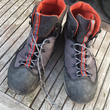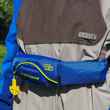Fly anglers are overloaded with gear choices—rods, reels, boots, waders, lines, packs, bags, boxes, vests, apparel and more. It seems harder and harder to know what's worth coveting and what's worth ignoring. Gear reviews are a great way to explore in-depth what might be right for you, but not every piece of gear is suited to a full-length review and, even if it were, there's simply too much of it to get to. With that in mind, we periodically showcase what's working for us right now, to hopefully offer more helpful feedback on gear that's worth a second look.
All gear is welcome here: new, old, cheap, pricey, and so on. The goal is to provide useful feedback on gear that works—not to help gin up marketing for new products. Sometimes, great gear has just hit the market, other times it's been here doing good work all along.
Patagonia Stealth Sling Pack
After trying most every type of vest and pack known to man, and having decided that chest packs and fly fishing vests and waist packs have too many inherent flaws, I’ve settled on sling packs. Yet even sling packs have their issues. For example, it seems like almost every sling pack designer puts the shoulder strap on the angler’s right shoulder. In my case, that’s my casting shoulder. After a long day of fishing and casting, my left shoulder feels just fine while my right shoulder feels like it’s been pummeled by the pack’s concentrated weight and the repetitive motion of my casting.
Not good. Not good at all.
Fortunately, Patagonia recently released an innovative new sling pack. The pack, which is called the Patagonia Stealth Sling, boasts the exceptional quality and attention to detail that we’ve come to expect from Patagonia’s fly fishing lineup. At 10 liters, it will hold several fly boxes, your leaders & tippets, and all the various & sundry other items you’ll want to carry for half a day on the water. In addition, it has a padded shoulder strap, magnets for your tools, a fly patch for your flies, an exterior sleeve for a water bottle or jacket, and a removable waterproof pouch for your car keys or cell phone.
Of special note, the Stealth Sling (pictured above) is made from 100% recycled nylon and polyester. Even better, you can … drumroll, please … customize the Stealth Sling to wear it on either shoulder. (Amen, and hallelujah!)
So if you’re looking for a versatile and innovative system to keep your gear handy on the water, but out of the way when you don’t need it — and if you want to give your casting shoulder a break from the concentrated weight of your sling pack — I’m pleased to report that the Patagonia Stealth Sling is an excellent option.
— Todd Tanner
BUY THE PATAGONIA STEALH SLING PACK

Telos TR2 Tent
Spring and summer are finally here and here to stay, which means camping season is kicking into high gear. Whether your camping adventures take you deep into the Yellowstone backcountry to chase feisty cutthroat trout, to diminutive brook trout streams tucked into the nooks and crannies of the Appalachian mountains, or somewhere altogether different, those of us that like to hike far and long to find solitude and wilderness appreciate lightweight gear that keeps our aging shoulders and backs from aching. Unfortunately, saving on weight (a good thing) has always meant getting cheated on space (a bad thing). That is, until Sea to Summit designed the innovative Tension Ridge system found in its Telos TR2 tent.
The architecture of the Tension Ridge system is actually a Jake Lah product. If Lah’s name doesn’t sound familiar, don’t worry. Unless you’re a serious outdoor gear nerd, it most likely won’t. But to those that geek out on such things or, more likely, those that work within the bowels of the tent industry, Lah is widely known as “The King of Tents.” Lah, the founder and head designer at DAC poles, has spent the last 30 years revolutionizing and re-revolutionizing aluminum pole and tent design—and he’s at it again with the TR2.
The TR2’s single, multi-hubbed pole features the Tension Ridge—a inverted upper section—whose shape results in significantly more interior space thanks to a ceiling that’s hoisted much higher than the TR2’s competitors and walls that are pitched almost vertically instead of slanting sharply in to confine occupants. At a little over 3 pounds, the plenty-light Telos TR2 might not satisfy die-hard ultralighters, but for the vast majority of backpackers, serious ones included, the extra interior space afforded by the Tension Ridge system is well worth an extra few ounces on the trail. Add in the fact that the TR2 is quick and easy to set up, offers excellent ventilation, is freestanding, that either the tent or its rainfly can be pitched independently, and the total package that is the Telos TR2 may just be the best tent I’ve ever used.
— Chad Shmukler

Big Agnes Sidewinder SL Mummy Sleeping Bags
Since we’re talking about camping, there’s something you should know: I hate mummy bags. Hate. I’m using the word hate, here. About mummy bags. For decades I’ve taken on extra trail weight, given up significant space savings, and sacrificed a lot of warmth just to avoid mummy bags.
For most of those years, the reason was because I’ve always rolled over and repositioned a lot during sleep. For people that move around a lot while they’re sleeping, mummy bags are torture devices. Some are so movement restrictive, that any type of repositioning is a fruitless exercise, akin to struggling in a straight jacket. Attempts to roll over in traditional mummy bags usually just make a bad situation worse. Most often, sleepers turn inside the bag while the bag itself moves just a little or not at all, leading the bag to corkscrew and constrict, like a Chinese finger trap that handcuffs you as you twist rather than pull.
In more recent years, I’ve added a new reason to ditch mummy bags: thanks to degeneration in the discs between several vertebrae in my lumbar spine, I’ve become a dedicated side-sleeper. Much like mummy bags are the enemy of moving sleepers, they are the bane of side-sleepers, as well. With tapers and patterns designed for campers that sleep on their backs, traditional mummies are uncomfortable and confining for side-sleepers.
Big Agnes’ Sidewinder SL sleeping bags are designed to tackle both of these issues at once. Patterned and cut for comfort when side-sleeping and designed to move with sleepers when they roll to reposition, the Sidewinder bags (which perform as promised) are a dream come true for mummy bag haters like myself. During a recent weeklong rafting trip through Dinosaur National Monument and the Gates of Lodore on Utah's Green River, each night was spent rolling, tossing, and turning in unrestricted bliss thanks to the Sidewinder SL.
And, as one would expect, they come with all of the hallmarks of Big Agnes’ best bags: made from 100% recycled materials, a strategically designed and placed down/synthetic hybrid insulation system, a PFC-free and water-resistant ripstop nylon outer, an uber-comfortable PFC-free polyester taffeta lining, plus lots of extra thoughtful features like a mesh pillow pocket, well-functioning jacket-style hood, and external loops for hanging.
— Chad Shmukler
BUY THE BIG AGNES SIDEWINDER SL SLEEPING BAG

Somewear Global Hotspot
Whether your fishing and camping adventures take you deep into the backcountry where injuries and wildlife and other mishaps can present sometimes life-threatening challenges, or just into rural areas where cellular phone service is spotty or entirely absent, being able to stay connected is not just convenient, it’s an investment in safety and responsibility. Sure, some folks scoff at the idea of being connected when traveling in the wilderness. But they shouldn’t.
Taking advantage of technological advancements enhances one’s ability to enjoy the great outdoors. It doesn’t diminish it. After all, weatherproof tents were a technological leap at one point. As were maps. And compasses. And flint and steel. Staying connected when far from civilization brings confidence and peace of mind. And that’s worth its weight in gold when you’re miles into the backcountry, where something as simple as a sprained ankle—not to mention unexpected weather events, a chance encounter with a bear, and so on—can spell disaster. And then, of course, there’s the matter of those you leave behind that worry. Being able to do something as simple as send a message that says, “Another great day in the valley. All is well,” goes a long way.
It’s also worth noting that in the case of the Somewear Global Hotspot, we’re not talking about a high-speed internet connection that will have you posting to Instagram and watching Tik Tok videos in your tent instead of stargazing. Somewear’s Global Hotspot provides an invaluable array of connected tools, but that’s it. Namely, Somewear offers wilderness goers GPS-assisted SOS (in partnership with GEOS Worldwide), GPS-fueled map navigation, on-demand weather updates, two-way text messaging, and GPS location tracking which will allow other members in your traveling party and those back home to pinpoint your location in near real time (on all but its most expensive enterprise plans, Somewear updates your location every 10 minutes).
The Somewear Global Hotspot isn’t a one-of-a-kind product. There are offerings from well-known competitors that offer a smaller, similar, or bigger suite of tools. We’ve tested several of them. What stands out about the Somewear Global Hotspot is convenience and ease-of-use. Many of Somewear’s competitors offer systems that saddle you with lots of extra or bulky gear, feature complex user interfaces, involve lengthy setup times and, often, long wait times waiting for satellite discovery. Somewear pairs with your smartphone, its app provides a clean, easy-to-navigate interface, and you can go from unpacking the unit’s box to communicating on its satellite network literally in seconds. Often, it’s almost hard to believe how quick and simple setting up and using the Somewear Global Hotspot is.
What’s more? Somewear’s data plans are attractively priced. You can get going for as little as $8.33 a month, and if you’re willing to pony up $30 per month (only for the months you need it), you can get a plan that offers generous usage limits. Jump to $50 and you get unlimited text messages and location updates. Weather reports are unlimited on all plans.
— Chad Shmukler
BUY THE SOMEWEAR GLOBAL HOTSPOT

Christopher Elbow Chocolates
Okay, chocolate doesn't technically count as gear. But I love good chocolate. A lot. As a matter of fact, it makes me just a little nervous when folks say that they don’t care for chocolate. It’s like when someone tells me that they dislike dogs, or they’d rather eat tofu than steak, or they prefer leaky waders. Any reasonable person is going to take a step back from a tofu-eating dog-hater with wet pants.
Maybe even two steps.
Getting back to chocolate … I should point out that not all chocolate is made the same. Most, in fact, aspire to a point somewhere between barely edible and mediocre. If I could be so bold as to offer some advice, I’d caution you to stay away from the chalky, tasteless stuff that gives chocolate a bad name. Instead, you should beg, borrow or steal a little really good chocolate to stash in your fly fishing pack or vest. (Okay, maybe not steal …)
What kind of chocolate, you might ask? Well, Tom Rosenbauer of Orvis makes some exceptional bean-to-bar dark chocolate that is worth slightly more than its weight in gold. It’s not for sale, however, and assuming that you’re not a close personal friend of Tom’s, you’ll need to look elsewhere. With that in mind I suggest spending some time perusing the Christopher Elbow Chocolates website. Furthermore, I’d point you towards the “Craft Chocolate Bars” page, where you can choose between dark chocolate bars originally sourced from Madagascar, Vietnam, the Dominican Republic, Haiti, Venezuela, Ecuador, Belize, Nicaragua, Colombia, Peru and Tanzania.
I sampled a number of Christopher Elbow dark chocolate bars last fall when I spent time on the Henry’s Fork. They are beyond stellar. So you, as a fly fisher, may indeed opt to spend your money on fancy fly rods, reels, and waders. I, however, am choosing another path. I’ll be the guy skimping on gear and keeping my sling pack full of Christopher Elbow Chocolate.
I’ll also be the guy with the huge smile on his face. Bon Appétit.
— Todd Tanner




























Comments
Gordon replied on Permalink
I've been so lucky as to have some and Rosenbauer makes damn good chocolate. That said, I don't leave for the water without a bar of Christopher Elbow Chocolate in my pack.
Pages